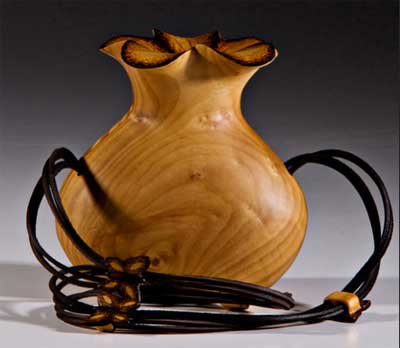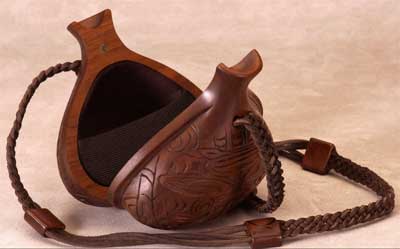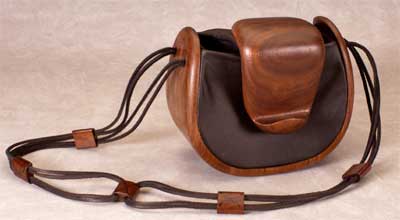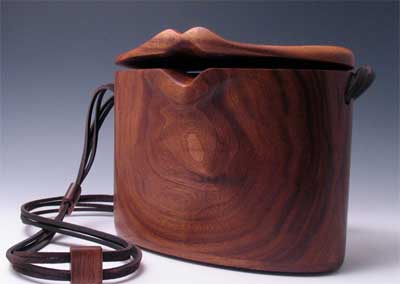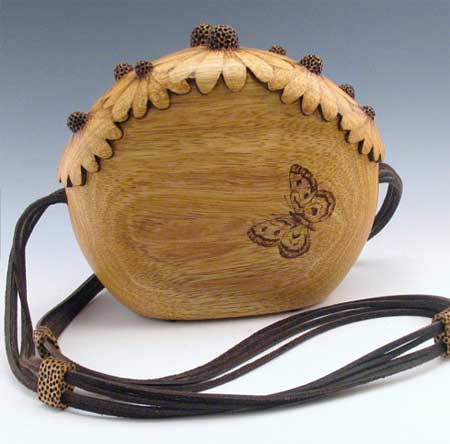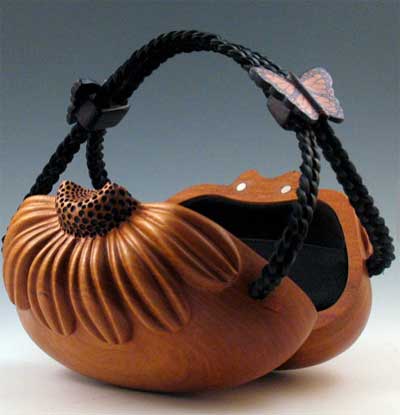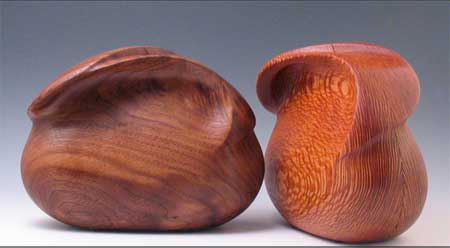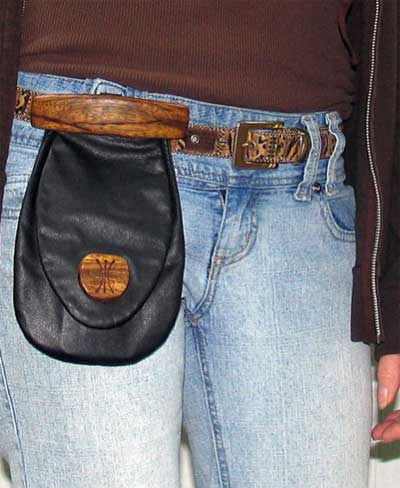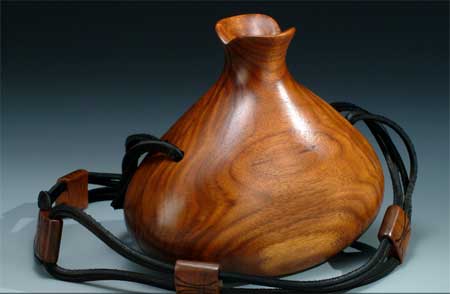
These days, Kimberly Chalos’s work focuses exclusively on her wooden handbags. It’s a niche that she found accidentally.
Kimberly’s original plan, when she went to college, was to become a graphic designer, but “one of my professors kept talking about how it was a dog eat dog world,” so Kimberly started looking for a different outlet for her art. “I took one woods class, and was hooked after that.”
She spent a few years working for Karges Furniture after her graduation, while also making some things for herself. “I would come home and look through my art history books to find things I wanted to hang on my walls.” At one point, she made a reproduction of a West Coast Tlingit rattle, and, as it lay in two hollowed-out pieces on her table, ready for her to put the rattle in, “I noticed what a cool purse it would be. It was small enough I would even carry it,” Kimberly said.
At the time, she didn’t actually carry a purse. (She didn’t wear rings, either; her first husband, now deceased bought her a Craftsman band saw for a wedding present in lieu of a wedding ring because “that’s what I really wanted,” while her parents, who were not woodworkers, delighted her at Christmastime with additional tools.)
Kimberly’s purses have since become her business. For a while, she was taking them on the art show circuit, but a flood in her home last year which brought five feet of water into her basement workshop – where all of her purses and tools were stored –has led, through assistance from CERF (Craft Emergency Relief Fund) to an opportunity for a new direction.
At 54 years old, Kimberly said, being on the road all the time left little time for new designs – when she got home, all she had time to do was make more inventory before heading back out on the road.
Of course, she did get some design ideas from customers at shows. One woman’s comment that, while she liked the wooden handbags, she “kind of wanted something soft on ‘em, too,” led to Kimberly’s line that incorporates leather along with the wood. And many people saw lips in her purses that utilized a design based on two leaf forms. “When they saw lips, it just made ‘em smile,” Kimberly said. “I thought ‘That’s kind of cool. I could have a design with lips and smiles,” which led to her “Gabby” series.
Many of Kimberly’s designs are based on nature, “leaf, flower and critter,” as she put it. “I just walk around my yard and look at the flowers and the critters. There’s skinks all around my yard, and beautiful brown-eyed Susans.”
Many of her purses now also reflect the types of designs she did back in college, when she was making a lot of large sculptures, yet functional pieces, using the human form as inspiration.
The purses, she said, have “soft, flowing curves, just like in my larger sculptures. They open up with hidden hinges, so it looks all natural. I didn’t want any metals or anything.”
When she goes to the lumberyard, Kimberly said, “I might spend two hours looking around, looking at the grain of different wood. If I don’t have to worry about weight,” any wood can work – but, for her all-wooden handbags, weight is a consideration.
“I have used maple on some smaller handbags,” she said. “Some smaller ones can use padauk.” She also uses a lot of walnut, and mahogany, and has used African black limba on a purse inspired by her brown-eyed Susan flowers.
The interior walls of the wooden handbags are quite thin, Kimberly said. She carves them out with a mallet and chisel; trying to get the right depth so the bag is not too heavy. She alternates her carving between the inside and the outside of a piece.
“For the Christine clutch, you’ve got to be able to clutch the bag when you carry it. I would hold onto it, then carve a little more. If I felt like it wasn’t comfortable in a certain spot, I would carve a little more there, while still paying attention to the design features on top of it. I didn’t want to lose the soft, flowing curve, where you easily grabbed onto it.”
For other bags, the handle is also a consideration: is it a short handle for a shoulder bag? Or a longer one? Often, Kimberly said, she’ll make a miniature clay model of a piece before doing the actual carving in wood.
The bags fashioned from both wood and leather don’t take quite as long to make as the all-wooden ones. Some of the inspiration for those, such as the clip-on bag line, came from Kimberly’s mother, who wanted something to hold her phone and her keys in when she takes walks.
(Kimberly’s mother also helps cut the leather and cut out patterns for Kimberly’s work; Kimberly taught herself to sew the leather when she began incorporating it into her work.)
Kimberly’s production process for her wooden purses also has an element which is likely familiar to many woodworkers: “Once I’ve finished one, I’ll think ‘I should have done it this way’ or ‘I should have done it that way.’ So I’ll make another one.”
